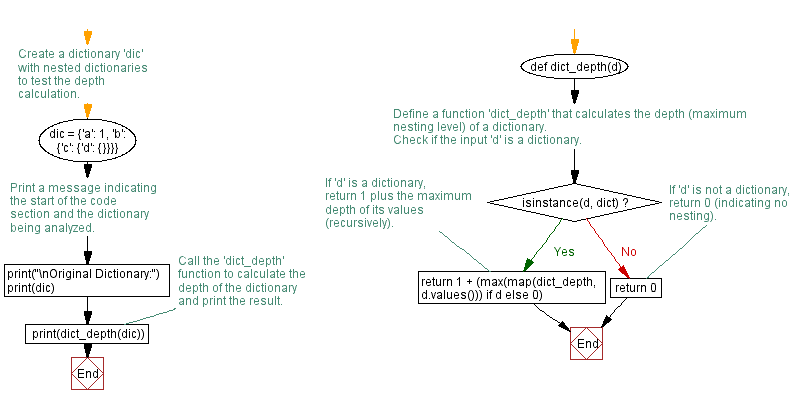Python: Get the depth of a dictionary
54. Get Depth of a Dictionary
Write a Python program to get the depth of a dictionary.
Sample Solution:
Python Code:
# Define a function 'dict_depth' that calculates the depth (maximum nesting level) of a dictionary.
def dict_depth(d):
# Check if the input 'd' is a dictionary.
if isinstance(d, dict):
# If 'd' is a dictionary, return 1 plus the maximum depth of its values (recursively).
return 1 + (max(map(dict_depth, d.values())) if d else 0)
# If 'd' is not a dictionary, return 0 (indicating no nesting).
return 0
# Create a dictionary 'dic' with nested dictionaries to test the depth calculation.
dic = {'a': 1, 'b': {'c': {'d': {}}}}
# Print a message indicating the start of the code section and the dictionary being analyzed.
print("\nOriginal Dictionary:")
print(dic)
# Call the 'dict_depth' function to calculate the depth of the dictionary and print the result.
print(dict_depth(dic))
Sample Output:
Original Dictionary:
{'a': 1, 'b': {'c': {'d': {}}}}
4
Flowchart:

For more Practice: Solve these Related Problems:
- Write a Python program to recursively determine the maximum nesting depth of a dictionary.
- Write a Python program to implement a function that returns 1 for a flat dictionary and adds depth for nested dictionaries.
- Write a Python program to iterate over dictionary values and compute the depth when values are dictionaries themselves.
- Write a Python program to use recursion to track the nesting level of a dictionary and output its maximum depth.
Go to:
Previous: Find the length of a given dictionary values.
Next: Access dictionary key’s element by index.
Python Code Editor:
What is the difficulty level of this exercise?
Test your Programming skills with w3resource's quiz.
